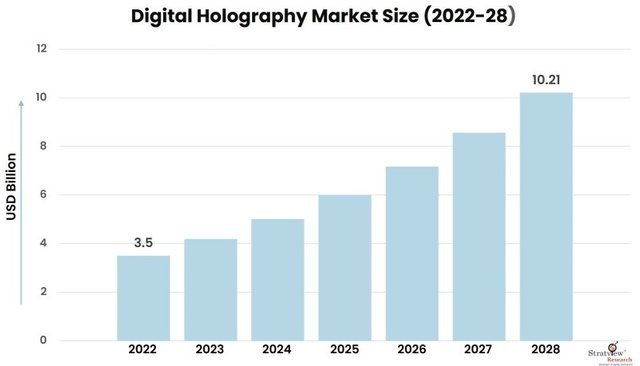Key Dynamics Fueling the Growth of the Digital Holography Market
The digital holography market is experiencing rapid growth, driven by a range of technological advancements, industry demands, and applications across diverse sectors. As industries increasingly adopt holographic technology for imaging, analysis, and display, the market is poised for significant expansion. Here are the key dynamics that are propelling this growth.
According to Stratview Research, the digital holography market was estimated at USD 3.5 billion in 2022 and is likely to grow at a CAGR of 19.51% during 2023-2028 to reach USD 10.21 billion in 2028.

1. Technological Advancements in 3D Imaging
One of the most important factors driving the growth of the digital holography market is the continuous innovation in 3D imaging technologies. Digital holography allows for the capture of high-resolution, three-dimensional images with precision, offering superior depth perception compared to traditional imaging techniques. The introduction of more advanced sensors, cameras, and computing power has improved the quality and speed of holographic imaging, making it more practical and accessible for industries like healthcare, manufacturing, and entertainment.
2. Growing Demand in Healthcare
The healthcare sector has become a significant adopter of digital holography, particularly in medical imaging and diagnostics. The ability to create detailed, 3D holographic images of organs, tissues, and cells is transforming how medical professionals approach diagnostics and surgical planning. Holographic technology enables non-invasive analysis, improves accuracy in medical procedures, and enhances educational tools for training medical personnel. As a result, the healthcare industry is contributing to the rising demand for digital holography solutions.
3. Increased Adoption in Automotive and Aerospace
In the automotive and aerospace industries, digital holography is being used for quality control, product design, and testing. The precision of holographic measurement systems allows manufacturers to detect even the smallest imperfections in components, improving overall product quality and safety. As these industries seek more efficient and accurate inspection methods, the integration of holography in manufacturing processes is becoming more common, further boosting market growth.
4. Growing Interest in AR and VR Applications
Augmented reality (AR) and virtual reality (VR) technologies are gaining traction in various sectors, and digital holography is playing a crucial role in enhancing these experiences. Holography can create immersive, realistic 3D environments, making it ideal for gaming, education, and virtual communication. As AR and VR continue to evolve, the demand for high-quality holographic displays and imaging solutions is expected to surge, contributing to the expansion of the digital holography market.
5. Rise in Research and Development Initiatives
Ongoing R&D efforts in optics and photonics are accelerating the adoption of digital holography. Academic institutions and private companies are exploring new applications, including security systems, data storage, and microscopy. This continuous exploration of new uses for holography is opening up new market opportunities, ensuring long-term growth.
Conclusion
The digital holography market is expanding rapidly due to advancements in 3D imaging, increasing demand in healthcare, growing use in automotive and aerospace, and the rise of AR and VR applications. As industries recognize the potential of holographic technology to enhance precision and user experience, the market will continue to thrive in the coming years.